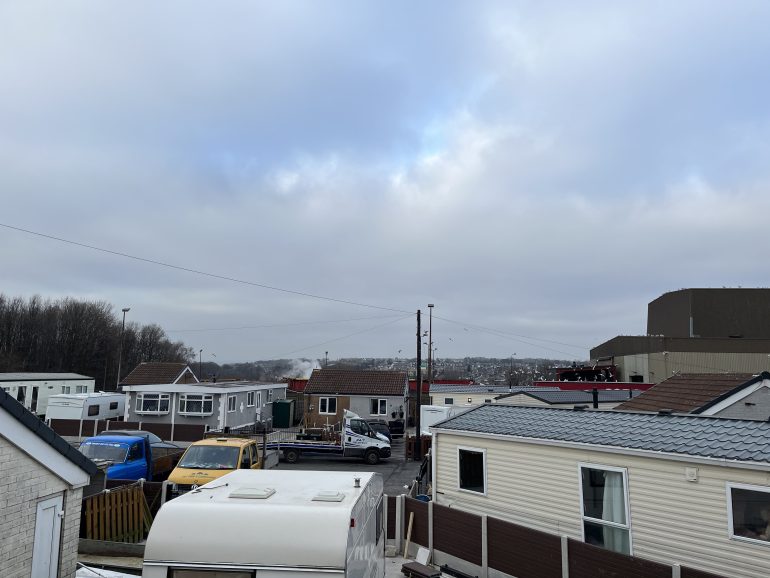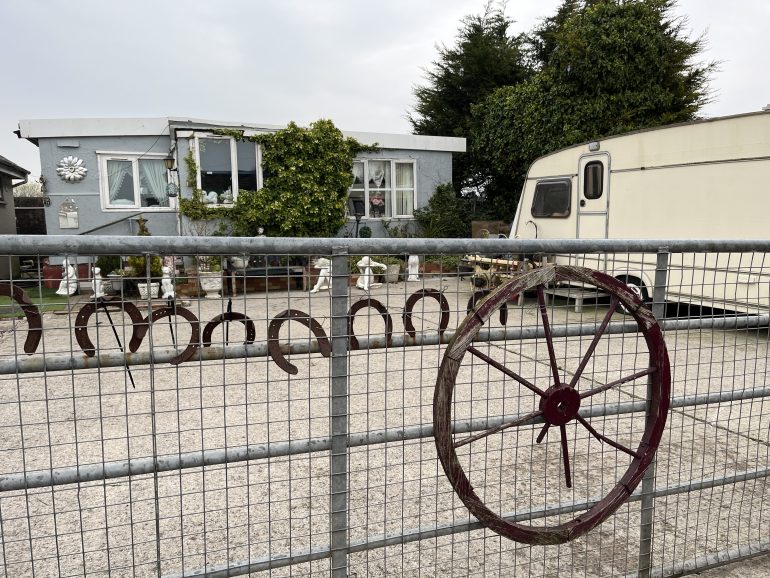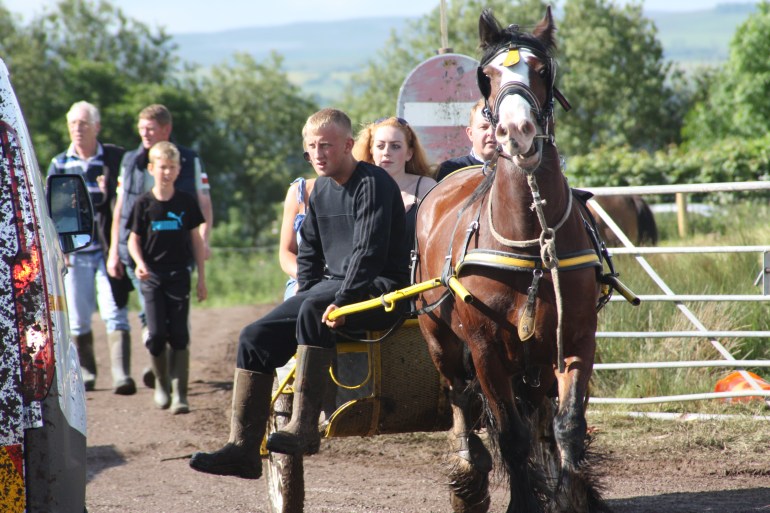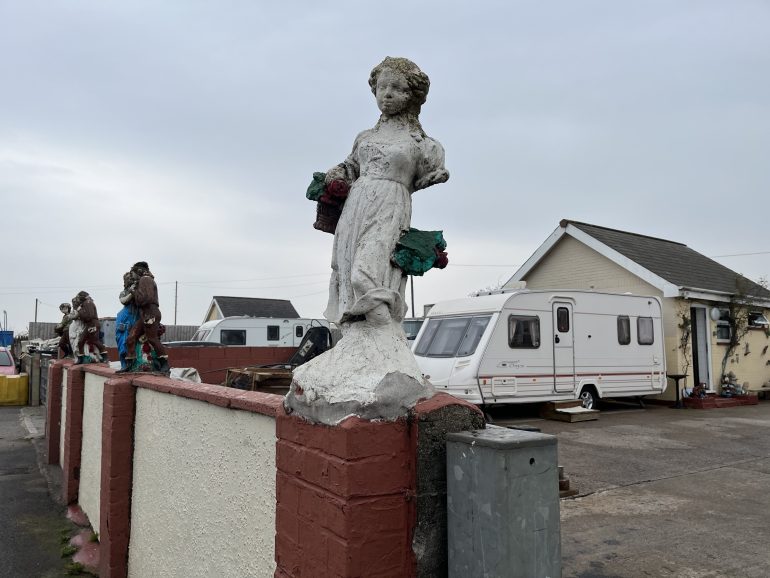Kathleenanne Boswell walks around the densely packed Mary Street Caravan site in Bradford, Yorkshire, where she has lived all her life. “We have a big problem with rats, a really big problem. We even have names for them,” she says matter-of-factly.
“George” – one of her rodent neighbours – “is as big as a Yorkshire terrier, so big he can’t even run,” the 30-something who is a senior youth worker for the local Traveller organisation, Leeds Gate, explains. “It’s no joke.”
Kathleenanne is a well-respected figure on Mary Street. She is eloquent about the problems her community faces on the site where tarmac internal roads lead to concrete slabs that anchor the trailers where residents live.
Four generations of the Boswell family have lived on the site in northern England since shortly after it opened in 1976; Kathleenanne’s grandparents “pulled on” in the 1980s – as Travellers term moving onto a new site, a van towing a caravan or chalet to a pitch.
Kathleenanne’s mum, who did not want to give her name, recalls moving onto the official site about 40 years ago, although as local Yorkshire people, they had camped nearby before: “We have always stopped around here. For breathing it was better then. It wasn’t green, and there was an awful smell from the chicken factory, but there wasn’t so much industry.” Her mum remembers how previously, the family would camp roadside in the area, stopping on patches of green land before they decided to move onto the site permanently. There was more housing in the area then, she recalls. Now mostly industrial activity surrounds them – scrapyards, car repair shops and even a demolition expert, which crushes bricks and building waste down for recycling.
Kathleenanne and her two young children share a chalet with her mum, while her elderly grandfather lives nearby. The site, about half the size of a football pitch, houses some 30 families crammed together on 28 pitches in sparkling clean white and cream caravans and chalets.
But just metres away, looming over the site, is the town’s recycling centre, a dull brown mass of metal at least six metres (20 feet) tall. Kathleenanne opens her chalet’s bedroom curtains each morning to the sight of skips being lowered and raised, with work there starting as early as 5am.

“The main problem is, we are living in an industrial area, and it’s the air quality, the smell, the dust and the noise,” she explains, also pointing out the floor-level runways that the rats follow along the edges of the fence between the recycling centre and the site. “There are gaps in the walls as the site was built so long ago, so the rats have access in and out of the site.”
The UK’s nomadic people
Estimates vary, but it is thought that there are about 300,000 members (PDF) of Travelling communities in the UK – less than 1 percent of the general population. About a quarter live on authorised sites (both public and privately owned), with other community members living in bricks and mortar (as do the estimated 200,000 members of the Roma population, who mostly live in poor quality rented housing in the UK). Most community members now stay put for most of the year, for education and work, and only travel during school holidays, particularly in the summer months.
A recent parliamentary report on the inequalities these communities face exposed problems varying from low levels of secure employment and lower educational outcomes for children, to startlingly poor health compared with the general population. Traveller life expectancy is 10-12 years less; Travellers are three times more likely to have respiratory problems, even after smoking is taken into account; and they have very high rates of death by suicide. One in five mothers will also experience the loss of a child under one month old, compared with one in 100 in the non-Traveller community. Analysis (PDF) of the 2011 census data (the most recent data available) also found that “Gypsy” and Traveller men and women have twice the rates of limiting long-term illness as white British people, and at each age they are the groups most likely to be ill.
Many Traveller sites like Mary Street were established in the 1970s, after the 1968 Caravan Sites Act placed a duty on local authorities to create sites for the UK’s nomadic people. The Act was an attempt to redress a series of laws which had eroded the right to camp and reduced the number of traditional stopping places, as camping grounds were known, meaning that Travellers ended up in increasingly dangerous roadside camps, without access to sanitation and other facilities.
However, across the country, local housed people set up action groups to oppose sites being created in residential areas, citing concerns about house prices, contamination, and some even refusing to have their children educated alongside Traveller children. Bill Forrester, who was tasked with finding some sites at this time, and was later chair of the National Association of Gypsy Traveller Officers, recalled planning meetings in the 1970s and 1980s. “It was very hard work, I’d go home sometimes and weep after public meetings, you despair for humanity really. You’ve got 400 people in a hall, and I remember one woman put her daughter on stage during a public meeting and said, ‘my nine-year-old daughter doesn’t want to go to school with Gypsies’”. Many authorised sites therefore got pushed to the margins of towns and cities.

At the entrance to Mary Street, a small hut, windows barred, overlooks the site. The site warden – a non-Traveller employed by Bradford Council – is friendly and gets minor repairs done quickly, Kathleenanne says, but can do nothing about the location of the site and the problems it causes. On a busy road running past the top of the site, trucks move past on the way to the recycling centre.
The site is built on sloping ground and there is a twenty-foot drop down another busy, dusty road, with trucks constantly driving up and down. The Council put up metal fencing with sharp spikes on top, to protect residents from falling, but Kathleenanne’s grandfather and other residents have blocked off access even further after a child lost part of a finger on the spiked fencing, and residents also feared that children could squeeze through and fall. Old doors and fence panels have been put to good use, but trucks can still be seen trundling up and down the road every few minutes, with dark smoke rising from beyond metal containers below.
“You can see the sand flying here every day; everything is covered in a layer of dust,” Kathleenanne says, walking up towards the top of the site. Every pitch has a neatly coiled hosepipe, and caravans and cars gleam as they dry off. Kathleenanne finds one car which has not yet been washed down and draws her finger over it. The dust is clear to see. “We are constantly hosing everything down, you have to wash it off as it corrodes the paint,” she says, adding, “There’s a lot of asthma and respiratory disorders on the site. Usually, asthma is worse in the winter, but here it’s worse in the summer, because the weather dampens down the sand in the winter.”
“Scrapyards on two sides of us, tip at the back, industrial units with tyres burning nearby, illegal of course. We haven’t got a clean space anywhere near here,” Kathleenanne says later, walking back to her chalet, to the warmth of tea and corned beef sandwiches. There is not a patch of green on the site, nor a playground for the 50-or-so children who live there.
‘Hole and corner sites’
In 1977, nearly a decade after the Caravan Sites Act was introduced, the UK government’s Cripps Report found that few sites for Travellers had been created and of those which had been, more than a quarter were in industrial areas, with 12 percent near rubbish tips. The report stated: “Large sums of money have been invested in hole and corner sites, excessively close to sewage plants, refuse destructors, traffic-laden motorways, intersections of those and other busy highways, main railway tracks and other features contaminating the environment by odour, noise and so on. No non-Gypsy family would be expected to live in such places”.
The report put the blame for site location squarely at the door of local politicians keen to keep their positions, instead of standing up to the housed people who opposed the placement of Traveller sites in their areas. Although Travellers technically have the right to buy land and live on it, when they seek planning permission to do so, their requests are disproportionately rejected (PDF), compared with the settled, or housed population. While three quarters of the Traveller population live in bricks and mortar, research has shown that this has an effect on mental health (PDF) in the communities, with many members expressing a wish to live on sites instead.

From November 2021 until May 2022, I explored the planning history behind where Traveller sites were located and the concerns that residents have about the condition of sites. I also mapped authorised “socially rented” sites over the last year – a definition which covers those managed by both councils and housing associations – 290 in all, across England, Wales and Scotland. I found that 39 percent were within 50 metres (164 feet, less than the width of an average football pitch) of major roads and motorways, railway lines, refuse and recycling plants, industrial estates, sewage works, rivers, canals or the sea, with more than half (54 percent) being within 100 metres (328 feet).
I made Freedom of Information (FOI) and Environmental Information Regulations (EIR) requests for 20 sites across the nations and visited Mary Street in Yorkshire and Rover Way in Cardiff, Wales, as well as another site which has just been approved by planning officials in Hertfordshire, north of London.
The planning history of the sites investigated showed that council officials were well aware of the risks of the locations in which they were placing Traveller sites; the EIR requests showed what can only be described as a hidden housing scandal. Residents raised concerns about sites plagued by insects and vermin, as well as complaining about noise and dust from industry and roads. Many sites were affected by foul odours from sewage stations and businesses such as slaughterhouses. Other problems included busy traffic and vibration from trucks and industrial processes, causing the concrete slabs on which trailers sit to crack.
Some sites, such as Rover Way in Cardiff, have been slated for closure for years, but because of objections, new sites cannot be found, so site conditions deteriorate and residents live in limbo. As so many are in industrial areas that have continued to develop around them, site conditions have got even worse than when they first opened. This becomes a generational form of what is known as environmental injustice.
‘You could gag from the smell’
Julie Price, a grandmother in her fifties, lives on Rover Way, which is next to a sewage pumping station and outflows into Cardiff Bay. She is proud of her heritage and of how she was “reared up” as a Traveller, but deeply concerned about her family’s living conditions.
“I can live with the rats, but I can’t live with the flies. I can’t live where I can’t cook in my own home in the summer,” she says over a cup of tea in her pin neat chalet, pictures of a smiling, tight-knit family all around.
Doreen Probert, another resident, beams in her cosy trailer, with its traditional cooking pots hanging from the ceiling, as her grandchildren and children pop in and out. But she also points to the sea, just metres away to the back of her trailer, and shudders.

“When high tides come, the sewer rats come up, the big black ones, up through the drains. You could gag from the smell,” she says. The beach behind the site is not one to take children to play on; it is strewn with rubbish and black mud, a sewage outflow marked on local maps near the site. “The smell of the sewage in the summer, it means you can’t eat your food outside, hang washing out to dry. In the summer we have to go to parks, and then when we get back, we put the fragrance plugs in and close the doors and windows.”
“Cardiff Council is aware of the issues raised and is in constant dialogue with residents of the site to look at ways we can help alleviate concerns,” a Cardiff Council spokesperson said about the Rover Way site, specifically mentioning the issues with dust, the environmental concerns, and pest control.
Planning officers are aware of the risks of the sites they approved – and have been for decades. In a planning document from 1974, the chief planning officer for the Bradford site said, as he passed it: “In my opinion the proposal envisages the introduction of a residential use into what is primarily an industrial locality and as such is unacceptable. However, I have been given to understand that the use of this site as a Gypsy encampment has been agreed in principle by this authority and as such I would therefore recommend that no objection be raised.” When I show Kathleenanne this planning document on my second visit to Mary Street a few months later, she is visibly upset. Holding the piece of paper, she says quietly that it shows all too clearly how Travellers were – and seem to still be – viewed by many in officialdom.
We walk through the site to visit other residents and to admire her grandfather’s bow top, the traditional wagons seen at horse fairs and religious meetings. Lovingly painted and preserved, it is a sign of happier times, when Travelling was not so restricted and when traditional stopping places – within living memory – still existed.
This week, the British government’s law to criminalise trespass comes into force. It will hit Travelling communities particularly hard, strengthening police powers against unauthorised roadside camps, with the additional threat that homes and belongings will be confiscated and offenders fined or even jailed. If Travellers cannot safely stop (transit sites are few on the road) many feel that they are effectively confined to sites like Mary Street, with bow tops in sheds, rather than out on the open road, the traditional way of life restricted.

“The health and safety of this already very disadvantaged group of people is being made worse by the terrible conditions they are forced to live in…” said Pauline Melvin, chair of the Traveller Movement, a national charity that supports the communities, “appalling conditions which in many cases would not be considered suitable even for animals.
“The general acceptance of these low standards is a sign of the desperation of people to maintain their nomadic or site-based life at all costs.”
‘In the middle of nowhere’
On a fine spring morning in April, Kathleenanne takes me to visit her neighbour, Roseanne Price, who was then expecting her third child. Her homey chalet, peppered with colouring books and her children’s toys, also overlooks the recycling centre. Roseanne, who was born in Bradford and had previously lived in a more isolated site, Esholt, nearby, says she has been here for about six years, as she has relatives to care for, rather than by choice.
“Esholt is in the countryside, very hidden away. That’s a big thing with Traveller sites, they are either in the middle of nowhere, or they can be found beside the factories, rubbish tips and industrial areas.”
She analyses her living conditions over a cup of tea. “We are run by the people who kill the rats; we pay rent as council tenants, but we are run by Environmental Health,” she says, referring to the department of local authorities in the UK which deals with pest control, food hygiene, air pollution and other public health issues. In fact, very few Traveller sites are run by the Housing department.
“The way I feel is like everybody else on the site, we have been brushed off,” Roseanne continues. “They just think, ‘you choose to live like this, this is your culture, it’s a lifestyle choice. You want to live here, so that’s it basically. This is all we have to offer you.’”
She says that although she values the close-knit community on the site, the place “smells like death, you can’t get away from it. You can close every door but it’s worse in the summertime, the smell of the rotting chickens. I do wonder, what it will be like when I have a newborn here. When the recycling goes off at five in the morning and I’ve just put the baby down. It feels like an earthquake when the skips are dropped. Then you hear the breaking glass and then the lorries reversing, beep, beep, beep.”
She drinks her tea and sighs. Like other residents, she feels powerless, their concerns largely shrugged off. “A lot of people on here, they suffer with their mental health and one of the biggest factors is that they are not listened to.”

One of the sore points for residents, which they feel shows how their concerns are unheard, is that in 2012, despite their protests, the current household waste recycling centre was approved by Bradford Council behind the site, building on what had been a smaller waste centre. The plans stated clearly that the recycling centre would increase in size, right beside the Traveller site. The operational activities would entail at least 15 trucks coming in every hour, with about 20 other vehicles on average entering and leaving each hour. The report stated that the Traveller site would suffer from noise and vibration, and that operational activities would result in emissions.
The environmental scoping report stated that the effects on Mary Street should be considered, that emissions could change the air quality within 5km (3 miles) of the site, including dust and particulate matter. Mary Street is within 50 metres (164 feet) of the waste centre, with some trailers just a few metres from the site.
Things have not improved since. When I submitted a request for information about environmental complaints from 2015 to 2021, the council responded that residents had indeed regularly raised concerns about rodents, insects, grit, dust, waste, noise and fly-tipping. Complaints on paper are one thing; to hear mothers talk of how they have to take their children in the dark to the utility sheds where they cook and bathe (in the traditions of Travellers, most do not bathe or cook where they sleep and socialise) – and kick rats away as they do so – is another.
Jo Richardson, a professor of Housing and Social Inclusion at De Montfort University, who is part of a new partnership to improve sites, told Al Jazeera that poor site management affects the health and wellbeing of residents, adding: “We should all have a decent place to call home.”
In response to a request for comment on the conditions at the Mary Street site, a spokesperson for Bradford Council said: “We have dedicated staff who work with residents at the Mary Street site and they work hard to do all they can to improve the conditions on the site and address issues as they arise for residents. Work is ongoing to look at longer-term solutions to address and tackle these and other issues.”

Rachel Cooper, the Development Director for Leeds Gate, told Al Jazeera that “years of institutional and societal racism” had “led to an untenable situation borne out in Gypsy and Traveller people’s life expectancy and suicide rates”.
“No other community would be expected to live on industrial estates flanked with tips and slaughterhouses,” she added.
A spokesperson for the UK Government’s Department for Levelling Up, Housing and Communities said: “We have made funding available to help councils make sure that Gypsy, Roma and Traveller communities have a safe place to call home.”
He said councils know their local area, are best placed to make planning decisions and are responsible for identifying land for Traveller sites, but added: “Our Planning Policy is clear that they should consider the effect of local environmental quality on the health and wellbeing of any travellers who may locate there when doing so.”
Feeling trapped
On a visit to Mary Street in late May, I get to the site in the early afternoon.
Kathleenanne’s young children are playing a new game, and we chat about it for a while before we sit down together. The children get changed for after-school activities and pile into the car with their grandmother and the chalet quietens.
We talk about holiday plans and the issue of trespass comes up, how so many residents now fear travelling and the possibility of being criminalised, even having their trailers destroyed.
They feel trapped on a site which may be home, but which is even more unpleasant to live on during the warmer months.
“It’s worse in the summer here, because you want to take your kids somewhere where they can feel nature beneath their feet,” Kathleenanne says, quietly. “Here you smell dead chickens, not cut grass.”
Post a Comment